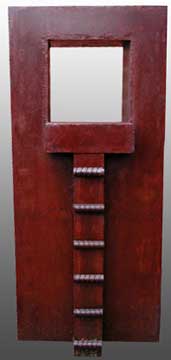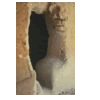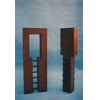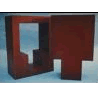
"Anasazi Grand Kiva Door -
Positive Form / Negative Form."
Steel. 1992. 40" x 18" x 14"
|
|
The
'Anasazi Details' sculptures are derived from the concept of levels
of knowledge. Although to the uninitiated, they appear as abstract
forms; they are in fact, derived from Anasazi architecture ( or
more correctly, details of architectural forms ).
|

|
Subject
The Anasazi were American Indians who resided in the four corners
( Utah, New Mexico, Colorado, Arizona ) area of the United States
from approximately 800 to 1400 AD. Their ceremonial lodge, the Kiva,
was a, usually, cylindrical structure built into the ground., and
entered via a ladder in a hole in the roof. The exception to the
rule is the grand Kiva, which is above ground entered from the sides.
The subject of the sculpture is the door form of one of these structures.
Object
The sculpure is derived from my interest in minimal forms, and positive
/ negative images. The previous sculptures in the series, four in
all, consisted of pairs of sculptures, each element of the pair
being either the positive ( actual ) or negative ( surrounding )
space of the subject. The final sculpture incorporates both the
positive and negative forms.
|
|


